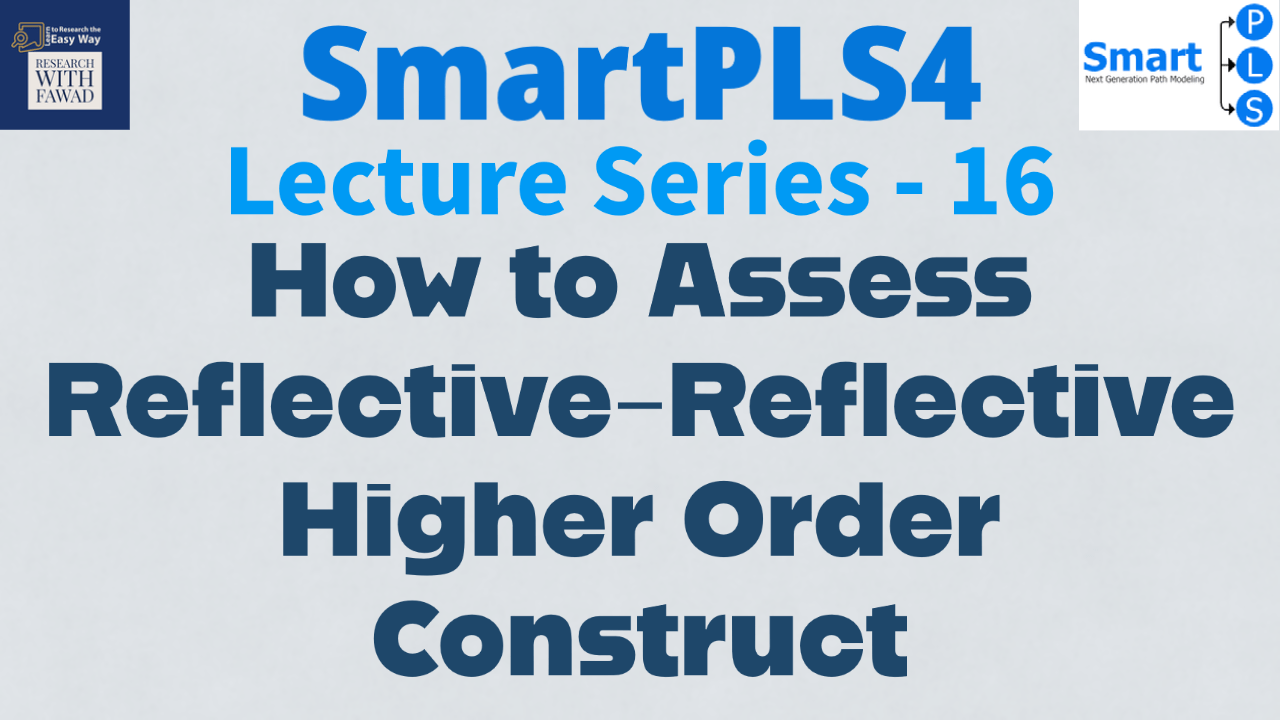How to Assess Reflective-Reflective Model in SmartPLS4?

Reflective-Reflective Higher Order Construct Analysis using SmartPLS4?
For Complete Step by Step SmartPLS4 Tutorial Playlist, Click Here
Understanding Higher Order Constructs.
A number of research papers and thesis require the models to have an increased level of complexity. Hence, scholars often try to develop models with multiple higher-order constructs in a single model. Those models may have reflective-reflective, reflective-formative, and lower-order constructs in a single model.
Building such models can be complex. In this and the next series of tutorials, I guide research scholars on how to build such complex hierarchical component models in SmartPLS4.
However, before scholars watch this video, it is recommended that they have knowledge of higher-order constructs and how they are analyzed. To learn more, please visit the following pages
Concept of Higher-Order Constructs
Reflective-Reflective Higher Order Model?
A widely debated Hierarchical Component Model (HCM) configuration is the reflective-reflective type. Critics argue that this type of HCM does not exist, or that it is meaningless because the reflective measures should be unidimensional and conceptually interchangeable. This conflicts with the view held by others that multiple underlying dimensions are distinct in nature.
Two Stage Approach for Analysis
Researchers have proposed the two stage approach as an alternative to the repeated indicators approach. In fact, research has proposed two versions of the two-stage approach,
- The embedded two-stage approach and
- The disjoint two-stage approach, which slightly differ in their model specification in both stages.
For example, while the embedded approach models the entire higher-order construct in its first stage, the disjoint approach initially only draws on the lower-order components (hence the denominations “embedded” and “dis- joint”).
As both versions of the two-stage approach lead to similar results, there is no compelling reason for preferring one over the other. In the following, we introduce first introduce the dis-joint two-stage approach for reflective-reflective type higher-order constructs.
Fornell and Larcker Criterion
A Reflective-Reflective Higher Order model may be assessed using Repeated indicators approach or Disjoint Two Stage Approach. In this tutorial the focus is on disjoint two stage approach. In Disjoint two stage approach, we follow the following mentioned procedure.
Stage 1
In the first stage create and estimate the model connecting all the lower-order components (Including Exogenous and Endogenous constructs). The model assessment first focuses on the reflective measurement models of the lower-order components. No Higher Order Constructs are modeled. Only LOCs for the HOCs are added to the canvas in the SMART-PLS. In the first stage all the LOCs are assessed for Reliability and Validity. The Measurement model is assessed as we normally do. for further detail, Click Here
After the Measurement model is assessed and reported (to learn how to report, Click here), use Latent Variable Score and save it in your data file to be used in the Second Stage.
Stage 2
In stage two, use the latent variable scores of the lower-order components from stage one to create and estimate for the stage two model.
For this purpose, locate the scores of LOCs of the HOC and add these as new variables to the dataset. The results are similar to the ones of the repeated indicators approach but with slight differences of the path coefficient estimates.
The evaluation of stage two starts with focusing on the reflective measurement model of the higher-order component. For HOC, see the loadings of LOC for the HOC, assess the CR and AVE using the coefficients (loadings) enabling us to establish indicator reliabilities and AVE.
These results above the critical value of 0.5. Cronbach’s alpha, CR and AVE establish reliability and convergent validity. Based on the HTMT criterion, discriminant validity with other LOCs can been established.
Finally, the assessment of the stage two results addresses the structural model. The analysis shall assess the structural model evaluation (e.g., significance and relevance for path coefficients, Q², PLS predict).
Reference
Reference
Sarstedt, M., Hair Jr, J. F., Cheah, J. H., Becker, J. M., & Ringle, C. M. (2019). How to specify, estimate, and validate higher-order constructs in PLS-SEM. Australasian Marketing Journal (AMJ), 27(3), 197-211.
Video Tutorials
Analyze Reflective-Reflective Higher Order Model
Report Reflective-Reflective Higher Order Model
Additional SmartPLS 4 Tutorials
- A Basic and Simple Model in SmartPLS4
- Basic SEM Concepts – Convergent and Discriminant Validity
- Basic Structural Equation Modelling (SEM) Concepts
- Categorical Moderation Analysis using SEMinR
- How to Assess Construct Reliability?
- How to Assess Convergent Validity (Construct validity)
- How to Assess Discriminant Validity (Construct validity)
- How to Design a Measurement Model?
- How to Enter Data in SPSS or Excel
- How to Solve Discriminant Validity Issues
- How to Use Necessary Condition Analysis in SmartPLS4?
- Reflective-Formative Higher-Order Model using SmartPLS4
- Simple Structural Model in SmartPLS4
- SmartPLS4 Tutorials Series Introduction
- Steps in Data Analysis
- What is a Formative Construct?